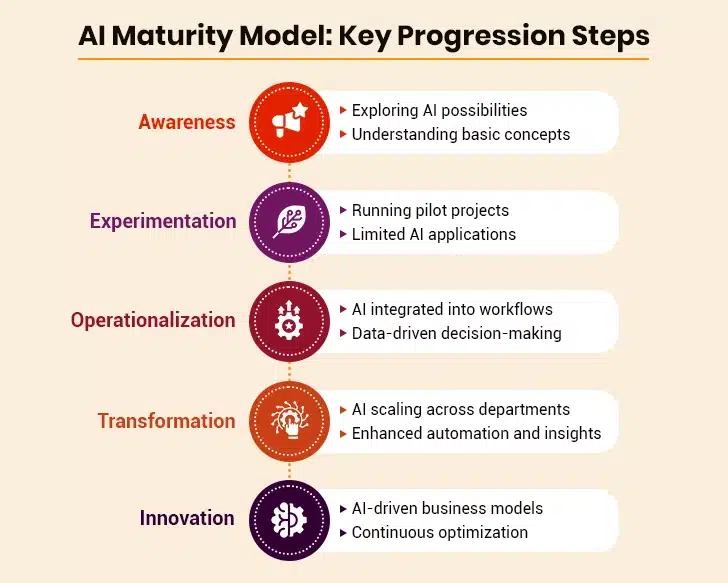Artificial intelligence is changing the way businesses work. It improves efficiency, cuts costs, and creates better customer experiences. However, not all companies use AI in the same way. Some are just starting, while others rely on AI for everyday tasks.
An AI maturity model helps businesses understand their position in the AI maturity journey. It shows how well they use AI and what steps to take to ensure the optimal utilization of AI in their business processes. By following a structured approach, companies can grow their AI capabilities. This blog explores the stages of AI maturity, key challenges, and how businesses can improve their AI adoption. Let’s get started.

Why Is AI Maturity Important?
AI can help businesses grow while cutting costs, improving service, and speeding up work. However, companies need to know how ready they are. The AI maturity model helps them see their weak areas. It also shows what they should do next.
Stages of AI Maturity
AI maturity has different stages. Each stage shows the kind of involvement AI has in a company’s work.
Awareness Stage
Companies in this stage are new to AI. They know AI exists, but they do not use it much. While leaders talk about AI, no actual work happens with AI-driven automation, and there are no concrete plans to use AI.
Experimentation Stage
In this stage, companies test AI by running minor projects to see how AI can help. They may use AI for tasks like customer service or data analysis. However, AI is not part of daily work. Instead, teams learn from these early experiments to understand AI’s potential benefits and limitations.
Operational Stage
Companies now use AI in daily work. AI tools help with tasks in various departments, including sales, marketing, and customer support. Teams have a better understanding of AI, and leaders support AI projects. However, AI currently only excels in a few areas.
Expansion Stage
AI is now a big part of the company. More teams use AI for different tasks, and the company has a clear AI strategy. Various teams use AI to improve customer experience, make better decisions, and save time and money.
Innovation Stage
At this stage, companies fully use AI, making it a part of every process. The company has moved toward AI-powered innovation, where they create new AI solutions. AI gives them an enormous advantage over competitors. They also use AI to predict trends and risks.
Key Areas of AI Maturity
AI maturity does not depend on just one factor. Different areas help measure a company’s AI maturity.
Strategy
A company needs a clear AI plan. Leaders should know how AI can help their business. They must set goals and decide how to reach them.
Data
AI needs good data to work well. A company should have a system to collect and manage data. The data should be clean and updated, as poor-quality data leads to inaccurate, biased AI results.
Technology
Companies must use the right AI tools. They should invest in AI software and hardware. Moreover, the AI systems should be easy to use and scale as the company grows.
People
Employees should understand AI. Training employees and hiring AI experts help businesses grow. As such, teams should learn how AI can help them work.
Processes
AI should fit into the company’s daily work. Businesses must update their methods to make the best use of AI. AI implementation should help improve speed and accuracy.
Challenges in AI Maturity
Many businesses face problems when adopting AI. Here are some common challenges:
Lack of Knowledge
Some companies fail to adopt AI because they lack a comprehension of how it works or how it can benefit them. Fear of new technology often deters them. Thus, leaders must teach teams about AI’s advantages and potential applications.
Poor Data Quality
Bad data makes AI useless. Hence, companies must collect and clean their data to remove errors and keep information updated.
High Costs
AI tools can be expensive, and many businesses do not have enough budget for advanced solutions. They should start small and scale their efforts.
Resistance to Change
Some employees fear AI would replace their jobs. Companies should teach employees how AI can help them. AI can remove tedious, redundant tasks so people can focus on important work.
Ethical Issues
AI must be fair and without bias. Hence, companies must use AI responsibly. They should monitor AI decisions to avoid unfair results.
What Is AI Maturity Assessment?
AI maturity assessment measures how well an organization adopts and uses artificial intelligence. It helps businesses understand their current AI capabilities and plan for future improvements.
The evaluation spans major areas, such as strategy, data, technology, people, and processes. It highlights strengths and weaknesses in AI adoption. Organizations use it to establish goals and make informed decisions regarding AI investments.
AI maturity usually has various levels. These go from elementary awareness to complete AI implementation in all business functions. Lower levels of AI maturity show AI as new or not widely used. At the same time, higher ones see highly ingrained AI fueling business expansion.
Organizations benefit from AI maturity evaluations. They improve operational excellence, minimize expenses, create better customer experiences, and gain a competitive edge. The outcomes help companies make the proper selection of AI instruments and techniques.
Companies assess their AI progress using surveys, expert evaluations, and industry benchmarks. They compare their progress to industry leaders and best practices.
Regular assessments help businesses keep up with AI trends. As AI develops, companies must adapt and refine their AI strategies. This ensures they stay competitive and maximize AI’s potential.
What is an AI Maturity Model?
An AI maturity model helps companies understand their AI journey. It has different levels, and each level shows how well a company uses AI. It helps businesses grow step by step. These models also make it easier to plan and invest in AI.

Benefits of AI Maturity Models
I. Clear Roadmap for AI Growth
An AI maturity model provides a clear roadmap for businesses. It helps them assess their current AI capabilities and set realistic goals. Organizations use an AI maturity assessment to measure progress. This structured approach ensures steady AI adoption. It also prevents businesses from investing in AI without proper planning.
The AI maturity framework outlines steps for improvement. Companies can focus on building AI skills at each stage. An AI maturity assessment tool helps track business readiness and gaps. Businesses avoid risks by following a structured plan. A well-defined AI capability maturity model enhances long-term success.
II. Better Decision-Making
The AI competency model supports better decision-making. It helps leaders understand AI’s role in their business. Assessing AI maturity helps firms identify areas needing improvement. With this data, decision-makers can allocate resources wisely.
The AI competency framework ensures informed planning. Companies can prioritize AI investments effectively.
An AI maturity assessment tool offers insights into strengths and weaknesses. Leaders use these insights to create a solid AI strategy. The AI capability maturity model aligns AI growth with business goals. Smart decisions lead to higher efficiency and profitability.
III. Efficient Resource Allocation
AI investments require proper planning. An AI maturity model ensures efficient resource allocation. It helps businesses avoid overspending or under-investing. Maturity assessment highlights strengths and weaknesses. With this knowledge, companies can focus on areas that need attention. The AI maturity framework provides a step-by-step approach to investing in AI.
A maturity assessment tool tracks progress and ensures wise spending. Companies distribute budgets effectively using the AI capability model. Efficient spending leads to better AI integration and business growth.
IV. Faster AI Implementation
Businesses that follow maturity frameworks implement AI faster. The AI maturity assessment identifies gaps early. Organizations can address these gaps before investing in AI tools. The AI competency framework ensures a structured approach to AI adoption. It helps teams develop AI skills at the right pace.
An AI maturity assessment tool tracks implementation progress. The AI capability maturity model prevents delays by ensuring readiness. Faster AI adoption helps companies stay ahead of competitors. Proper planning reduces AI deployment challenges.
V. Reduced AI Risks
AI adoption comes with risks. An AI maturity model helps businesses minimize these risks. It identifies security and ethical risks. Firms can address these risks before scaling AI. The AI maturity framework provides guidelines for responsible AI use.
Companies use maturity assessment tools to track compliance. The AI capability model ensures risk mitigation strategies are in place. By following structured steps, businesses avoid costly AI mistakes. Safe AI adoption builds trust with customers and stakeholders.
VI. Enhanced AI Performance
The AI progression framework helps businesses improve AI performance by highlighting weak areas in AI systems. Companies can enhance these areas to optimize results.
The AI maturity framework ensures AI operates efficiently. An AI maturity assessment tool provides regular performance reviews. The AI capability model helps refine AI strategies. Businesses achieve better AI outcomes through structured improvements. Higher AI performance leads to increased productivity and innovation.
VII. Stronger Competitive Edge
A well-planned AI strategy gives businesses a competitive edge. The AI maturity model helps companies stay ahead. The AI maturity assessment identifies growth opportunities. Companies can leverage AI to improve services and operations.
The AI progression framework ensures businesses use AI effectively. A maturity assessment tool tracks progress against competitors. The AI capability maturity model strengthens the market position. Businesses with advanced AI capabilities attract more customers. Competitive AI strategies drive long-term success.
VIII. Better AI Integration Across Departments
AI works best when integrated across different business functions. The AI maturity model ensures smooth AI adoption company wide. It also helps businesses identify gaps in AI integration. Companies can align AI with existing workflows using the AI maturity framework.
An AI maturity assessment tool measures AI’s impact across departments. The AI capability maturity framework promotes seamless AI collaboration. Well-integrated AI improves efficiency and communication between teams. Businesses achieve higher productivity with AI-driven solutions.
IX. Measurable AI ROI
AI investments must generate value. The AI maturity model helps businesses measure AI’s return on investment (ROI). It tracks cost savings and revenue improvements. Companies use the AI progression framework to ensure AI aligns with business goals.
An AI maturity assessment tool provides data on AI efficiency. The AI capability model optimizes AI investments. Measurable AI results justify further AI development. Businesses achieve sustainable AI growth through proper tracking.
X. Future-Proof AI Strategies
AI is constantly evolving. The AI maturity framework helps businesses prepare for future AI advancements, ensuring companies stay updated with AI trends. The AI progression framework supports continuous AI improvements.
An AI maturity assessment tool helps businesses adapt to changing AI landscapes. The AI capability maturity framework ensures long-term AI sustainability. Future-ready AI strategies keep businesses ahead of industry changes. For example, fintech firms use AI to detect fraud, automate loans, and personalize customer services. Companies that embrace AI maturity remain competitive in the long run.
Accelerate Your AI Transformation with Our Expertise
How to Improve AI Maturity?
Companies can take steps to grow in AI maturity. Here are some key actions:
1. Set Clear Goals
Businesses should define what they want from AI. Clear goals help teams stay focused. As such, businesses should use AI to solve actual problems.
2. Invest in AI Training
Employees should learn how to use AI. Companies should offer training programs and hire AI experts as and when needed.
3. Improve Data Management
Good data leads to good AI. Companies should collect accurate and useful data. They should also use AI tools to manage data better.
4. Use the Right Technology
Companies should invest in AI tools that fit their needs. They should choose software that is easy to use and expand.
5. Start Small and Scale Up
AI should grow step by step. Businesses can start with small projects. Once they see success, they can expand AI use.
Monitor and Improve
AI needs regular updates. Hence, companies should track AI performance. It helps them fix problems and find new ways to use AI.
Conclusion
AI maturity models help businesses grow their AI capabilities step by step. They provide a clear roadmap, reduce risks, and improve decision-making. Companies that assess their AI maturity can plan better, allocate resources wisely, and integrate AI across departments. By investing in training, data management, and the right technology, businesses can move toward AI-driven success. A structured approach ensures long-term benefits, keeping companies competitive in a digital landscape.





